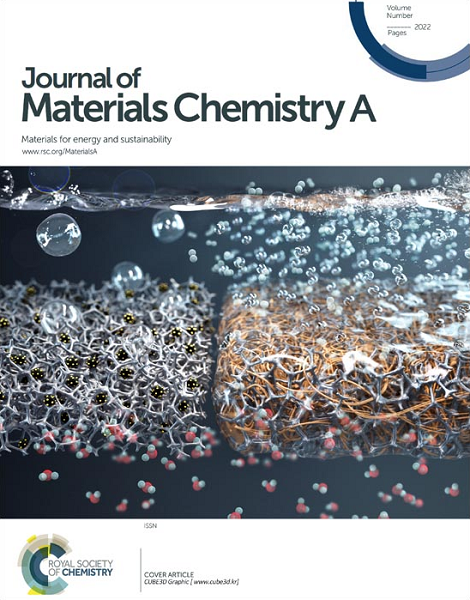高能量密度锂金属电池用原位Li3N改性厚度可控的超薄阳极
IF 10.7
2区 材料科学
Q1 CHEMISTRY, PHYSICAL
引用次数: 0
摘要
采用薄锂金属阳极(LMAs)来调节镀/剥离行为可以实现高能量密度的锂电池。然而,常规的锂金属箔由于其机械脆弱性和可加工性差,不可避免地在商业化应用中面临重大挑战。在此,我们提供了一种简单的工艺,利用氧化石墨烯(GO)衬底合成厚度可控(10 ~ 50 μm)的薄的、独立的LMAs,并在电极表面生成Li3N的原位人工界面层,增强了Li的润湿性,引导了Li的均匀沉积。精心设计的三维结构缩短了Li+的输运路径,氮掺杂碳纳米纤维(NCF)纵向散布在石墨烯层之间,提高了电子输运效率,提高了电导率。厚度可控的超薄材料减少了锂的浪费,有利于实现高能量密度电池。超薄锂金属阳极(表示为NCF/rGO/Li3N)对称电池能够在1 mA cm-2下稳定镀/剥离超过1500 h。NCF/rGO/Li3N||LFP全电池在液体电解质和固体电解质中均表现出优异的性能。NCF/rGO/Li3N||NCM811袋状电池具有低负/正(N/P)比(2.3),在60次循环后平均能量密度为310 Wh kg-1,容量保持率为93.5%。超薄LMA优异的电化学性能为实现高能量密度电池提供了一条很有前途的途径。本文章由计算机程序翻译,如有差异,请以英文原文为准。
Ultra-thin anodes with controlled thickness modified by in situ Li3N for high-energy-density lithium metal batteries
The employment of thin lithium metal anodes (LMAs) to regulate plating/stripping behaviour can achieve high energy density lithium batteries. However, the routine Li metal foils inevitably face significant challenges in commercial availability due to the mechanical fragileness and poor machinability. Here, we provide a simple process to synthesize thin, freestanding LMAs with controllable thickness (10 ~ 50 μm) using graphene oxide (GO) substrate, and generate an in situ artificial interfacial layer of Li3N on the electrode surface, which enhances Li wettability and guides the homogeneous deposition of Li. The well-designed 3D structure shortens the Li+ transport path, and the nitrogen-doped carbon nanofibres (NCF) interspersed longitudinally between the graphene layers increase the electron transport efficiency and improve the electrical conductivity. The ultrathin material with controllable thickness reduces the lithium wastage, which is conducive to the realization of high-energy-density batteries. The ultra-thin lithium metal anode (denoted as NCF/rGO/Li3N) symmetric cell is capable of stable plating/stripping for more than 1500 h at 1 mA cm‒2. The NCF/rGO/Li3N||LFP full cell exhibits excellent performance in both liquid-based electrolytes and solid electrolytes. The NCF/rGO/Li3N||NCM811 pouch cell, with a low negative/positive (N/P) ratio (2.3), can offer an average energy density of 310 Wh kg‒1 with 93.5% capacity retention after 60 cycles. The excellent electrochemical performance of the thin LMA provides a promising avenue for achieving high-energy-density batteries.
求助全文
通过发布文献求助,成功后即可免费获取论文全文。
去求助
来源期刊

Journal of Materials Chemistry A
CHEMISTRY, PHYSICAL-ENERGY & FUELS
CiteScore
19.50
自引率
5.00%
发文量
1892
审稿时长
1.5 months
期刊介绍:
The Journal of Materials Chemistry A, B & C covers a wide range of high-quality studies in the field of materials chemistry, with each section focusing on specific applications of the materials studied. Journal of Materials Chemistry A emphasizes applications in energy and sustainability, including topics such as artificial photosynthesis, batteries, and fuel cells. Journal of Materials Chemistry B focuses on applications in biology and medicine, while Journal of Materials Chemistry C covers applications in optical, magnetic, and electronic devices. Example topic areas within the scope of Journal of Materials Chemistry A include catalysis, green/sustainable materials, sensors, and water treatment, among others.
 求助内容:
求助内容: 应助结果提醒方式:
应助结果提醒方式:


